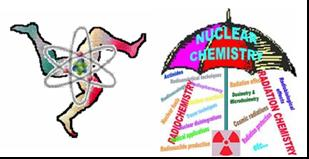Speaker
Dr
Mikhail Alyapyshev
(Khlopin Radium Institute)
Description
The treatment of the high level waste generated during nuclear fuel reprocessing is the obligatory stage of the nuclear fuel cycle. The reducing of volume of nuclear wastes could be realized by recovering of all harmful radionuclides (actinides, lanthanides and fission products) to separate fractions and their encapsulating in appropriate stable matrices. Separation of minor actinides (Am and Cm) from relatively harmless lanthanides is one of the most important and challenging problem due to their chemical similariry.
On the one hand the most well-known extraction processes developed for actinide partitioning use neutral polydentate ligands solutions as a solvent, for instance CMPO (octyl(phenyl)-N,N-diisobutyl carbamoyl methylene phosphine oxide), TRPO (tri-n-alkyl phosphine oxide), diamides of malonic and diglycolic acids. All listed compounds possess very high affinity to f-elements and effectively extract them from nitric acid solutions but cannot separate the minor actinides from rare earth elements. The high complexing ability of these extractants is caused by presence in their structure of hard donor atoms (oxygens of ethers and carboxylic groups) that form strong complexes with both actinides and lanthanides. That is why “hard donor” ligands could be used only for simultaneous actinides and lanthanides recovery.
On the other hand the most powerful agents for selective extraction or separation of trivalent actinides are nowadays “soft donor” compounds which possess several nitrogen or sulfur atoms. Some poly-nitrogen compounds extract americium many times better, than europium. However the main drawback of such ligands is that for some them the effective Am/Eu separation is possible only from solutions with low concentration of nitric acid (pH 2-4) and the others are not stable in nitric acid solutions.
The combination of hard and soft donors in one structure allows effective extraction of actinides and their separation from lanthanides in the one stage. Two different classes of heterocyclic acids diamides (diamides of 2,6-pyridine dicarboxylic acid and diamides of 2,2’ dipyridyl-6,6’-dicarboxylic acid) were synthesized and systematically studied. Several extraction systems for extraction and selective separation of actinides (SF (Am/EU) up to 30) were developed and tested.
Primary author
Dr
Mikhail Alyapyshev
(Khlopin Radium Institute)
Co-authors
Dr
Natalya Borisova
(Moscow State University)
Dr
Vasiliy Babain
(Khlopin Radium Institute)




